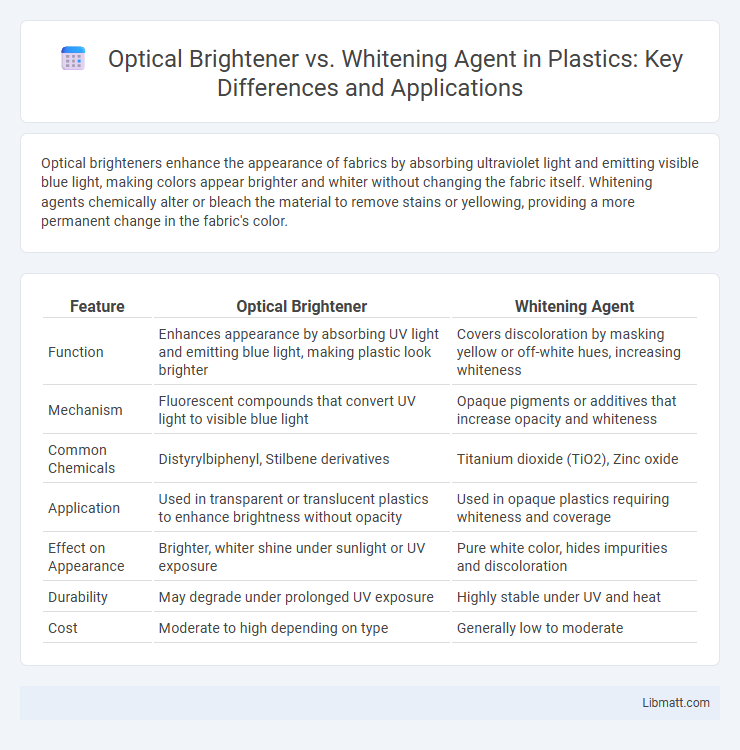Optical brighteners enhance the appearance of fabrics by absorbing ultraviolet light and emitting visible blue light, making colors appear brighter and whiter without changing the fabric itself. Whitening agents chemically alter or bleach the material to remove stains or yellowing, providing a more permanent change in the fabric's color.
Table of Comparison
| Feature | Optical Brightener | Whitening Agent |
|---|---|---|
| Function | Enhances appearance by absorbing UV light and emitting blue light, making plastic look brighter | Covers discoloration by masking yellow or off-white hues, increasing whiteness |
| Mechanism | Fluorescent compounds that convert UV light to visible blue light | Opaque pigments or additives that increase opacity and whiteness |
| Common Chemicals | Distyrylbiphenyl, Stilbene derivatives | Titanium dioxide (TiO2), Zinc oxide |
| Application | Used in transparent or translucent plastics to enhance brightness without opacity | Used in opaque plastics requiring whiteness and coverage |
| Effect on Appearance | Brighter, whiter shine under sunlight or UV exposure | Pure white color, hides impurities and discoloration |
| Durability | May degrade under prolonged UV exposure | Highly stable under UV and heat |
| Cost | Moderate to high depending on type | Generally low to moderate |
Understanding Optical Brighteners and Whitening Agents
Optical brighteners are chemical compounds that absorb ultraviolet light and emit visible blue light, enhancing the appearance of whiteness by making fabrics or paper appear brighter and less yellowed. Whitening agents typically include bleaches and other chemicals that remove stains or brighten materials by breaking down discoloration at the molecular level, resulting in a visibly cleaner and whiter surface. Understanding the distinction between optical brighteners and whitening agents is essential for selecting products tailored to specific cleaning or aesthetic needs in textiles and paper products.
Chemical Composition and Mechanisms
Optical brighteners are fluorescent compounds, typically derivatives of stilbene, that absorb ultraviolet light and emit visible blue light, enhancing fabric whiteness by counteracting yellow hues. Whitening agents, often based on inorganic compounds like titanium dioxide, work by reflecting and scattering visible light to increase the perceived brightness of materials. The chemical composition of optical brighteners involves complex organic molecules with conjugated systems, whereas whitening agents rely on particulate substances that modify light interactions without fluorescence.
How Optical Brighteners Work
Optical brighteners work by absorbing ultraviolet light and re-emitting it as visible blue light, which enhances the appearance of whiteness and brightness on fabrics and paper. These fluorescent compounds mask yellowish hues, creating a perception of cleaner and sharper whites without altering the material itself. Unlike traditional whitening agents that bleach or chemically alter the substrate, optical brighteners provide a non-destructive, light-enhancing effect through fluorescence.
The Science Behind Whitening Agents
Whitening agents work by chemically breaking down stains and discoloration on surfaces or fabrics, often through oxidation or reduction reactions, enhancing the material's natural brightness. Optical brighteners, on the other hand, function by absorbing ultraviolet light and re-emitting it as visible blue light, which masks yellowish tones and creates the perception of increased whiteness. Understanding the distinct mechanisms behind these agents can help you choose the appropriate product based on whether you need physical stain removal or visual color enhancement.
Key Differences: Optical Brightener vs Whitening Agent
Optical brighteners are chemical compounds that absorb ultraviolet light and emit blue light, enhancing fabric brightness and creating a visually whiter appearance without altering the material's actual color. Whitening agents, often bleaching chemicals like hydrogen peroxide, work by removing or decolorizing stains and impurities to lighten the fabric itself. The key difference lies in their mechanisms: optical brighteners produce a refractive luminescence effect, while whitening agents chemically modify or eliminate color pigments.
Applications in Textile and Paper Industries
Optical brighteners enhance the appearance of textiles and paper by absorbing ultraviolet light and re-emitting it as visible blue light, making materials appear whiter and brighter without altering their chemical properties. Whitening agents, often chemical bleaches or pigments, physically remove or mask yellowing but may weaken fibers or reduce durability in textiles and paper products. Your choice between optical brighteners and whitening agents depends on desired brightness effect and material longevity in applications such as fabric finishing and paper coating.
Efficacy in Whitening Performance
Optical brighteners enhance whitening performance by absorbing ultraviolet light and emitting visible blue light, creating a brighter and whiter appearance on fabrics and paper. Whitening agents, such as chlorine-based bleaches, chemically remove stains and discoloration, resulting in a more permanent whitening effect. Optical brighteners provide an immediate visual boost without altering the material's chemical structure, whereas whitening agents offer deeper, more durable stain removal.
Safety and Environmental Impact
Optical brighteners, commonly used in laundry detergents and paper products, absorb UV light and emit blue light to enhance whiteness, posing minimal toxicity but potential persistence in aquatic environments. Whitening agents such as hydrogen peroxide or chlorine bleach actively remove stains through chemical reactions but can release harmful byproducts, requiring careful handling and disposal to minimize environmental damage. You should consider the balance between optical brighteners' long-term ecological impact and whitening agents' immediate chemical hazards when selecting products.
Choosing the Right Whitening Solution
Optical brighteners absorb ultraviolet light and emit visible blue light, enhancing fabric whiteness by creating a perception of brightness without altering the fabric itself. Whitening agents, such as bleach, chemically remove stains and discoloration to achieve a true whitening effect. When choosing the right whitening solution, consider the fabric type and desired outcome; Your choice should balance the need for immediate brightness with long-term fabric care.
Future Trends in Whitening Technologies
Future trends in whitening technologies emphasize the development of safer, eco-friendly optical brighteners that enhance fabric brightness by absorbing UV light and re-emitting it as visible blue light. Advancements include bio-based whitening agents that reduce environmental impact while improving durability and wash fastness in textiles. You can expect innovations combining optical brighteners with nanotechnology for more effective and long-lasting whitening performance.
Optical brightener vs whitening agent Infographic

 libmatt.com
libmatt.com